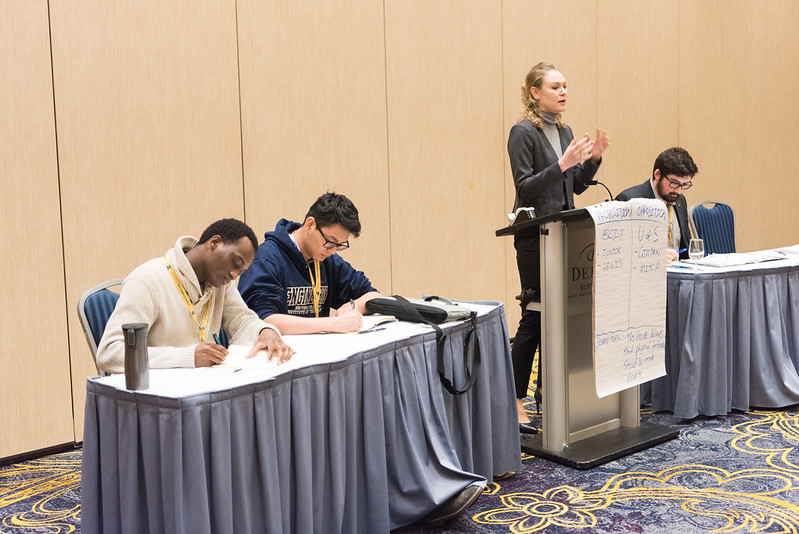BCIT, the first polytechnic to host the Western Engineering Competition, wins senior design competition.
To the untrained eye, the supplies scattered on the tables at this year’s Western Engineering Competition might look like the remnants of an arts and crafts project. To knowledgeable observers, however, the popsicle sticks, rubber bands and paper clips represent much more.
Dr. Forrest Tittle, dean of the British Columbia Institute of Technology School of Energy, sees students applying the concepts they’ve been taught at BCIT. BCIT is serving as host of WEC in a Burnaby hotel.
“Over there, you see her working on structural strength and load-bearing ability,” he murmurs of a student busily gluing popsicle sticks together in layers. Another, creating triangle shapes out of the sticks, is using the principle of rigidity.
BCIT is the first-ever polytechnic Institute to host the student-run conference, which pits teams of engineering students from more than a dozen post-secondaries in B.C., Alberta, Saskatchewan and Manitoba against each other in friendly competition.
That’s the spirit in which Terry Calderbank, a third-year electrical engineering student at BCIT, took part. His team competed in the senior design competition, where the challenge was to build a bridge for use in Venice. Their team won.
“A lot of people talk about putting this on their resumes, but that’s not why we did it — we just wanted to have some fun and try our skills against other schools,” he says. “It feels good to win as a team of friends.”

Calderbank says engineers often have to address working within the constraints of time, budget and resources. He attributes the team’s victory to finishing before the time limit was up, having a model that actually worked (lighting system and all), and keeping the swing bridge-inspired concept simple.
BCIT alumnus Sean Garrity has been a volunteer and competitor at WEC; this year, he has returned as a judge. He credits getting his job — even before he had graduated in 2013 — to the connections he made at WEC, along with the profile involved in his victory. The challenge in that case involved making a presentation about the best way to deal with a hypothetical oil spill, which was outside his realm of learning as an electrical engineer.
“When you’re working as an engineer, it’s pretty common to always be learning and adapting while on the job,” Garrity points out. “Knowing how to problem solve and get to a solution — like in this competition — is what matters.”
Glenn Pellegrin, an instructor within the BCIT electrical and computer engineering technology program, agrees that ‘soft skills’ like communication and teamwork have become increasingly important in the modern era. Many systems are now much more complicated and sophisticated than in the past, making it nearly impossible for one individual to know everything about it.
“There’s a mantra of ‘technical skills get you hired, interpersonal skills — or the lack of them — get you fired’, which is to say, you can be a smart individual but if you can’t communicate and get along, no one’s going to want to work with you,” Pellegrin says. “That includes both clients and colleagues.”
He believes BCIT helps make graduates more job-ready by focusing on hands-on education. Instructors translate what’s in textbooks into practical contexts, with exposure to workplace environments with industrial equipment.
Tittle, the dean, adds that engineering labs are deliberately designed to have small numbers of students, ensuring more enriched learning than just sitting in large lecture halls. He says BCIT excels at keeping its finger on the pulse of where the job market is going, thanks to its deep relationships with industry partners.
“We’ve recently added the mining engineering degree program because of demand,” he says. “Whenever industry people come to campus for tours, they’re always amazed by the quality of the labs and the curriculum, and we see that with hiring — more than 90 per cent of our students who get degrees are employed right away.”
As he looks around the Burnaby hotel conference room, he acknowledges that the school — and engineering as a whole — still needs to do more about recruiting women, but is happy with some of the progress already being made. You can see he is proud to see the best and brightest students taking on the challenges of the competition, showing employers they’re also getting ready for the challenges of the modern working world.
This story first appeared in The Vancouver Sun, January 20, 2018 with credit to Claudia Kwan – Postmedia Content Works.

